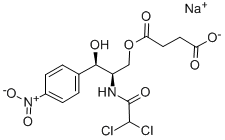White or yellowish-white powder, hygroscopic
antibacterial, antirickettsial, inhibits protein synthesis
Chloramphenicol Succinate Sodium is a derivative of Chloramphenicol (C325030) which are broad spectrum antibiotic obtained from cultures of the soil bacterium Streptomyces venezuelae. It has a broad spectrum of activity against Gram-positive and gram-negative bacteria. Antibacterial; antirickettsial.
Chloramphenicol succinate sodium is the salt prepared from chloramphenicol succinate using the free carboxylic acid of the succinate which ionises and readily forms in weakly sodium hydroxide solutions. The sodium salt is the preferred formulation for pharmaceutical applications, providing a more readily soluble product. Chloramphenicol succinate is significantly less active than chloramphenicol but acts as a prodrug, forming chloramphenicol in the presence of succinate dehydrogenase.
Chloramphenicol sodium succinate is the water-solublesodium salt of the hemisuccinate ester of chloramphenicol.Because of the low solubility of chloramphenicol, the sodiumsuccinate is preferred for intravenous administration. Theavailability of chloramphenicol from the ester followingintravenous administration is estimated to be 70% to 75%; theremainder is excreted unchanged. Poor availability ofthe active form from the ester following intramuscular injectionprecludes attaining effective plasma levels of the antibioticby this route. Orally administered chloramphenicol orits palmitate ester actually gives higher plasma levels of theactive antibiotic than does intravenously administered chloramphenicolsodium succinate. Nonetheless, effectiveconcentrations are achieved by either route.
Flash point data for Chloramphenicol sodium succinate are not available, but Chloramphenicol sodium succinate is probably combustible.



